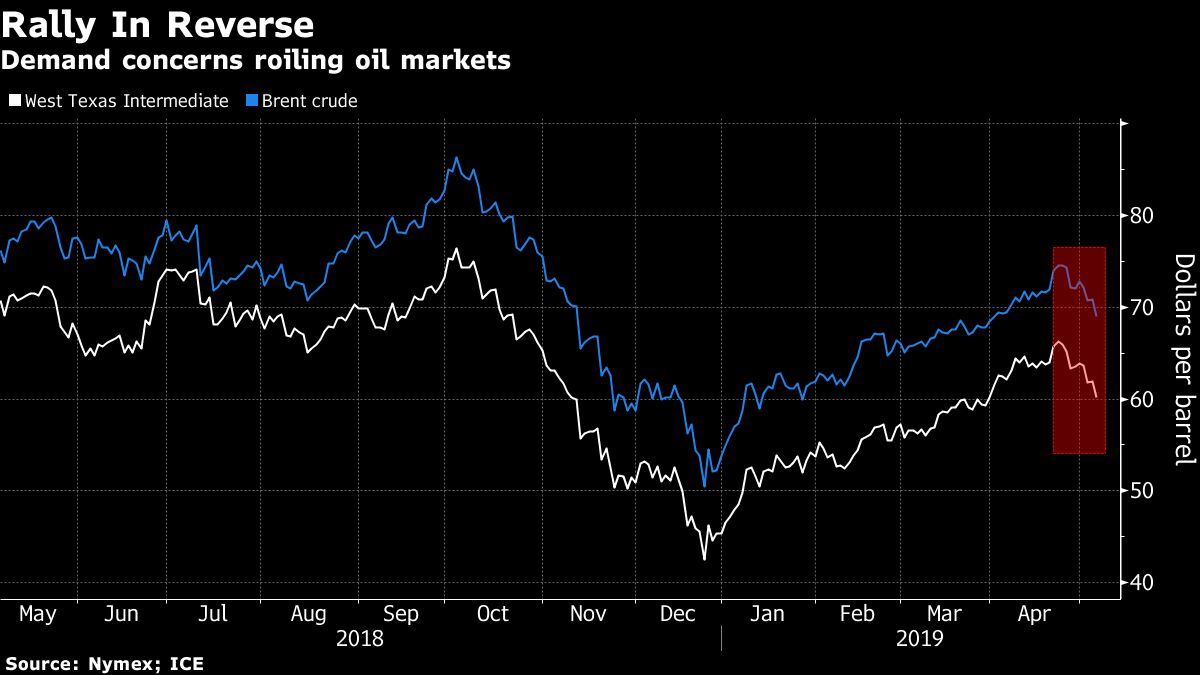Oil holds above $60 as supply concerns counter Trump trade talk

Oil recovered from early declines after U.S. President Donald Trump threatened to escalate his trade war with China but also dispatched warships to the Middle East in a warning to Iran.
Futures in New York were little changed Monday after falling as much as 3.1 percent in early trading as investors fretted a U.S.-China deal was in jeopardy, stoking fears about the global economy. They recovered that ground amid heightened tension with OPEC member Iran.

U.S. crude has retreated around 7 percent since late April amid signs global markets may not be as tight as feared. While the possibility that the world’s two largest economies won’t reach a trade truce undermines prices, the decision to dispatch an aircraft carrier strike group and bomber force to the Middle East highlights conflicts in the heart of global crude production.
“The drop was due to fears that a trade war with China could cause a recession that sends oil prices lower,” said Ellen Wald, president of Transversal Consulting, an energy and geopolitics consultancy in Jacksonville, Florida. “The recovery is basically saying, maybe we shouldn’t have pushed it so far.”
Trump threatened on Twitter Sunday to not only double existing tariffs on Chinese exports to the U.S. but also raised the possibility of penalties on an additional $325 billion of goods
Trump threatened on Twitter Sunday to not only double existing tariffs on Chinese exports to the U.S. but also raised the possibility of penalties on an additional $325 billion of goods. Chinese Vice Premier Liu was set to arrive in Washington Wednesday for what had been shaping up as a potential final round of talks. After Trump’s warning, Beijing was said to be considering a delay.
West Texas Intermediate crude for June delivery fell 17 cents to $61.77 a barrel on the New York Mercantile Exchange at 11:25 a.m. It earlier dropped to $60.04, the lowest since March 29.
Brent for July settlement slipped 1 cent to $70.84 a barrel on the London-based ICE Futures Europe exchange, after slipping as low as $68.79. The global benchmark crude was at a premium of $8.89 to WTI for the same month.
Countering the trade malaise, the U.S. announced the deployment of a bomber force and aircraft strike group. National Security Adviser John Bolton called it “a clear and unmistakable message” to Iran that any attack on U.S. interests or on those of its allies will be met with “unrelenting force.”
Iran has threatened to block the Strait of Hormuz, a chokepoint for crude shipments out of the Persian Gulf, after Trump tightened sanctions on Iranian barrels last week.
While the U.S. isn’t likely to allow any major disruptions to the Strait, “you’re sending more ships to a region that’s already really, really tight,” Wald said. “Even if there’s no actual closure, that kind of saber-rattling can get people on edge.”
Meanwhile, Saudi Arabia, the world’s biggest oil exporter, cut the cost of all crude grades to the U.S. for June, even as it raised prices for other regions.
The announcement appeared to be aimed at easing concern over supplies. But Aramco may also have offered a discount to compete with record American crude stockpiles. U.S. inventory data helped push oil prices lower last week, but the market has become “overly bearish,” said Bjarne Schieldrop, Oslo-based chief commodities analyst at Norwegian bank SEB AB.
(By Alex Nussbaum and Verity Ratcliffe)
{{ commodity.name }}
{{ post.title }}
{{ post.date }}


Comments